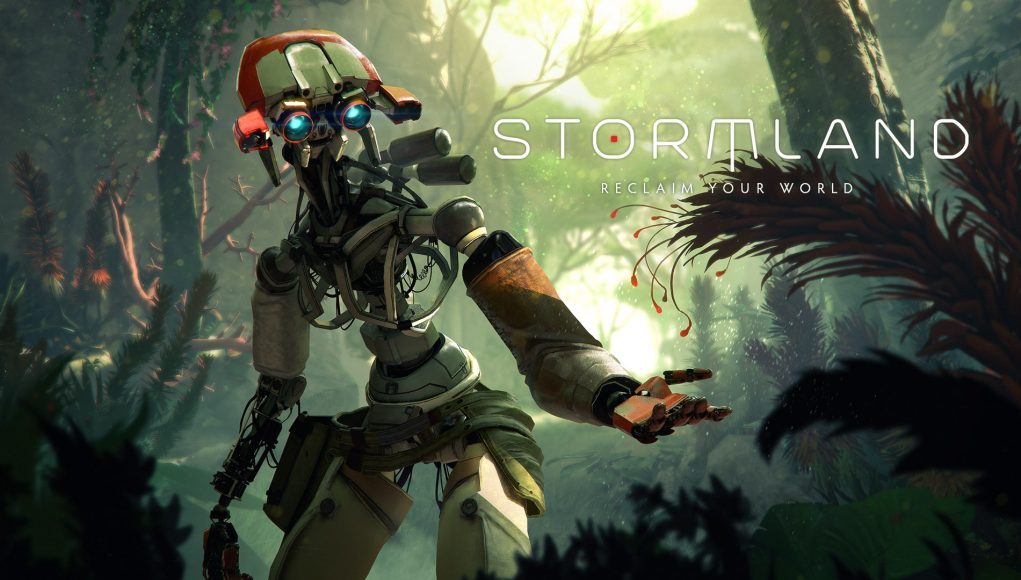With Stormland, Insomniac Games set out to figure out if an open-world adventure game could really work in VR. The result? Not just ‘the new bar’, but a rather high one at that (not to mention one of VR’s first great co-op games).
Stormland Details:
Developer: Insomniac Games
Available On: Oculus (Rift)
Reviewed On: Rift S, Rift CV1
Release Date: November 14th, 2019
Price: $40
Gameplay
Stormland is a VR open-world adventure game with a good deal of shooting, though I would stop shy of describing it as a ‘shooter’; while about half of your time will be filled with combat, the rest offers traversal, exploration, collection, and progression.
The game is fundamentally composed of several sizeable ‘Strata’ (you can think of these like map regions), each of which is peppered with islands of varying sizes. Between the islands is a landscape of clouds; when you step on the clouds you ‘Slipstream’, a very fast means of traversal compared to the stick-based locomotion that you’ll use when on land. While you’ll mostly be hanging out in a single Strata for large stretches at a time, you’ll progress from one to the other as you go, occasionally returning to ‘Base Camp’ (the lowest layer).
Stick-based locomotion and Slipstreaming are complimented very well with a climbing and gliding ability. You can pretty much climb anything at any time, and you’ll glide around whenever you wind up in the air. As you get skilled with using these different locomotion tools, you’ll be able to move around with an incredible feeling of freedom.
Insomniac’s decision to allow players to Slipstream when traveling between islands is quite genius. It effectively ‘shrinks’ the map, allowing the space to feel quite massive without burdening players with trudging from A to B with nothing interesting to do; Slipstreaming is itself the interesting thing to do between A and B, and it’s actually quite fun.
When you aren’t cruising the clouds, you’ll looking for valuable resources or laying the hurt on enemy androids using a reasonably sized arsenal which gets more powerful over time. Combat is well paced, pitting you against just a handful of more challenging enemies at a time (rather than heaps of fodder).
While the soldier-sized androids come in a few different flavors, the tactics you’ll use against them are mostly the same. Thankfully, flying drones, leaping snipers, static turrets, and hulking goliaths mix things up enough for combat to stay fresh and challenging, with a sense of reward for picking the right strategy for the situation. That said, enemy AI can feel pretty dumb and unaware at times (especially if you’re picking them off from afar).
Killing enemies in Stormland is a very satisfying affair thanks to well placed effects and sounds that really sell the destruction. After 10 hours in the game I was still enjoying the thrill of disintegrating an enemy android with a double-shotgun blast to the face.
It’s a good thing then that the game gives you tons of freedom regarding which weapons you use and the combat tactics you employ. ‘Workbenches’ scattered throughout the game allow you to fabricate any weapon that you’ve discovered in the world, as well as grenades, health canisters, and more. All weapons can be used with one hand, but gripping with two hands adds an extra benefit like increased rate of fire, stability, etc. I came to prefer carrying an SMG, shotgun, and sniper rifle with me as my usual kit, and then improvising as needed by snatching other weapons from dispatched foes.
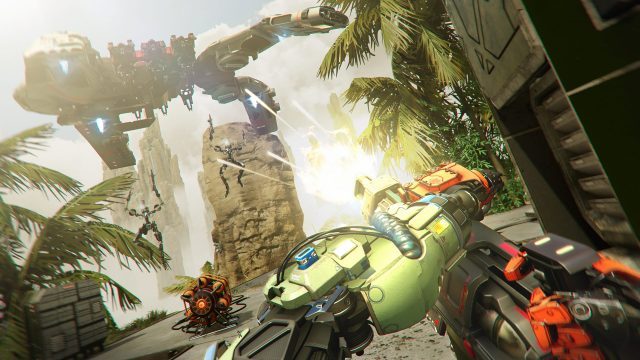
Stormland’s weapons don’t reload in the traditional sense. Rather than inserting a new magazine, weapons are actually ‘disposable’ by grabbing them with both hands and ripping them apart. This gives you both Alloy (the currency which you spend at Workbenches) and some ammo for that gun type. While magazine-based reloading can be a lot of fun in VR games, I think Insomniac made an excellent choice with Stormland’s weapon design in this regard; the gesture of tearing guns apart is an absolute joy, and this also means that even if you find a gun you don’t care for (which happens often) it’s still useful to you because it can be turned into Alloy and ammo. Insomniac clearly recognized the fun of this ripping/tearing gesture, as you’ll see it used in other places throughout the game (and surely, it will be picked up for use in other VR games too)
Alloy can also be found growing throughout the world of Stormland; you’ll shoot your hand laser at it to knock it free and see if vacuumed up into your inventory. Beyond Alloy, you’ll also want to snatch up any bio-fruit and Aeon Buds that you find. Bio-fruit recharges your special ability (things like invisibility or a stun gun), while Aeon Buds are a rare plant-based commodity which is important for upgrading your abilities.
Between scrapping enemy weapons, collecting the game’s various useful resources, and working toward whatever mission objective you’re on, Stormland makes it feel like there’s always something to do, be it around the corner, on the next island, or in the next Strata.
The game moves you along with a serviceable, but largely uneventful string of story missions which effectively introduce you to the fundamental workings of the game in preparation for the ‘Cycling World’.
After you complete the core story missions, you’ll be let loose to go tackle the Terminus in the Cycling World. The Cycling World is the state of the game’s Strata or regions; it’s identical for all players of the game and gets remixed once every calendar week. In the Cycling World you’ll be presented with a handful of missions in each Strata (similar to those found in the core story missions) and battle your way to the Terminus, the game’s highest and most challenging Strata. When the Cycling World turns over it brings new and rearranged islands, different missions, and new locations for enemies, objectives, resources, and more.
Conquering the Terminus will put your skills to the test, including understanding how to read your map and complete mission objectives which are not always easy to find. When you head to the Terminus you’ll want to make sure you’ve upgraded your skills and bring a full arsenal of upgraded weapons, grenades, health canisters, and the arm-skill of your choice.
Defeating the Terminus unfortunately doesn’t offer much of a sense of climax for the game (aside from being a fun challenge), but when the Cycling World turns over, you’ll be presented with remixed Strata and a new Terminus to defeat. If you beat the Terminus in the prior cycle, the next one will be even more challenging. In this way, Insomniac hopes that the Cycling World will create a sense of ongoing replayability for Stormland, while the escalating difficulty of the Terminus will amount to a bit of ‘end game’ challenge for players to dig into.
It took me about 9 hours from the start of the game to defeat the Terminus for the first time; because the Cycling World turns over only once per week, it’ll be a while yet before we know what kind of long-term replayability the game will have. Thankfully, even if you only battle your way to the Terminus once, Stormland is a compelling experience and a true framework for VR open-world adventure games.
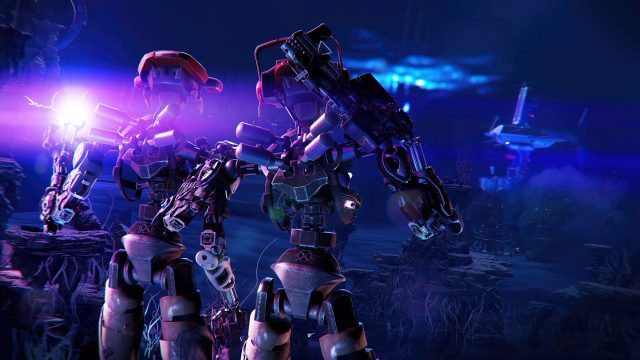
The cherry on top is Stormland’s two-player co-op. Although player-to-player interactions (like handing each other objects) need much more attention, the ability to traverse a huge continuous world with a friend is a joy. It’s really fun to be standing atop a high vista, see something interesting in the distance, and tell your friend ‘hey let’s go over there’, before leaping to the clouds and racing to the other side of the map. Because the game offers a strong element of freedom with regards to weapons and tactics, it’s also fun to collectively strategize by picking complementary loadouts.
Stormland on Original Rift CV1
While the majority of my time was spent in Rift S, I played about two hours of Stormland on the original Rift CV1 and found that it fared nearly as well as the Rift S. While the game is easier to play with 360 tracking, as long as you are adept at maintaining facing the front of your playspace (or if you have a 360 sensor setup with your CV1), you ought to be able to get just as much enjoyment out of the game.
Immersion
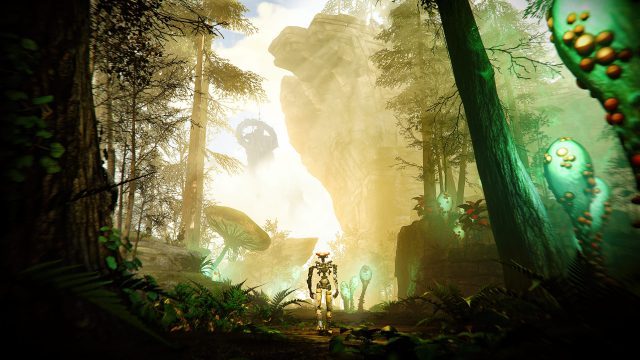
Stormland is a good-looking game which is occasionally downright gorgeous. While the islands that you’ll find yourself exploring are flush with flora and interesting terrain, it’s the cloudtop vistas that really bring out the ‘wow’ moments. Each Strata has a unique feeling which is deeply influenced by their strikingly different lighting conditions. Finding yourself up on a high vista, overlooking distant islands, and seeing the sun catch the clouds just right is only made more special by virtue of knowing that you can go out and travel to any of the islands you see before you.
The gentle onset of a spontaneous rainstorms brings with it a sense that the world is indeed living rather than static. These moments of beauty are unfortunately juxtaposed by some rough edges found elsewhere.
Early in the game you will receive the ‘Scanner’, a visor upgrade which basically highlights anything interactive or threatening within a certain radius. It feels like a cheap hack (in place of more thoughtful art direction and visual affordances) to help players locate useful stuff in the environment and to spot enemies among dense plant life.
Turning on the visor crowds your field of view with HUD elements while also highlighting seemingly half the world in front of you, no matter if it’s through a wall or not. This essentially collapses your sense of occlusion (which is closely tied to stereo-depth), while introducing tons of excess visual noise which makes it difficult to sort out what information is important rather than extraneous. In the middle of a gunfight, for instance, it’s all too easy to lose sight of your laser reticle amidst all the visual chaos. You can turn the scanner on and off at will (and believe me, I left it off as often as I could), but it is unfortunately essential to spotting enemies and finding key objectives.
This excess use of the visual channel is part of a broader trend. Both audio and haptics are also frequently abused with extraneous feedback that’s difficult to decipher among the mass of incoming information. ‘What did I just hear?’, ‘Who is shooting at me?’, and ‘Why does my hand seem to buzz randomly?’ were frequent questions on my mind as I played.
That’s an unfortunate sore spot in a game which is otherwise incredibly thoughtful and borderline groundbreaking in its VR design.
I could write an entire article on Stormland’s smart VR design (yes, even beyond this one), but to keep this review concise, I’ll slipstream through a few highlights.
For one, the game presents an entirely spatial interface to the player. It isn’t perfect, but it’s a huge step forward compared to the laser-pointer interfaces seen in so many other games. Interface elements are generally laid out as virtual touchscreens, including a spatialized map which has an ‘augmented reality’ style view where a 3D representation floats right there in space for you to look at. This is a good foundation, but another pass on usability (especially for left-handed players) would be welcome.
Second, Stormland has a fully spatialized inventory system. Once fully unlocked, you’ll have two hip holsters, two shoulder holsters, and three chest slots (for grenades and energy canisters). While this is steadily becoming par for the course, it’s the details that matter; the game actively prevents you from dropping anything that you’ve holstered. If you accidentally drop your gun in the middle of a firefight, it will levitate in front of you for a moment before flying back to your holster. The same thing applies to grenades and other items. This simple but effective system goes such a long way to de-clunking the moment-to-moment VR experience.
Third, interactions feel great. I already talked about ripping guns apart to collect Alloy. This satisfaction carries through to most things in the game, like harvesting fruit by grabbing it and then crushing it in your hand, activating grenades by pressing a button on top, grabbing levers, and activating elevators. It feels good because Insomniac spent a lot of time figuring out how to intuit what the player is trying to do and then helping them do it while making it look reasonably good (we got a behind-the-scenes look at that in this piece). While this occasionally goes awry (like when the game sometimes thinks you want to grab your weapon instead of grab for a climbing hold), it’s generally a positive for how the game plays and feels.
A quick minor point: I would have loved to see both a flashlight and binoculars in Stormland.
Comfort
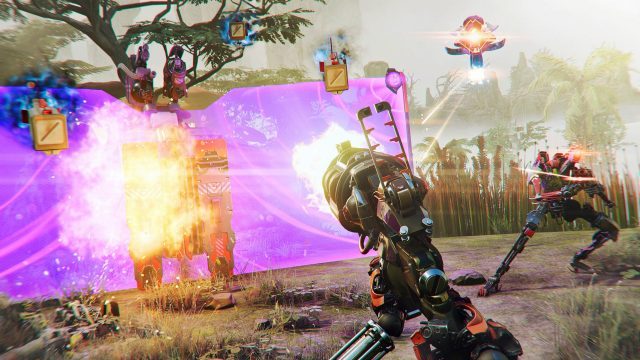
Though Stormland does an impressive job of maintaining player comfort, it has tons of artificial movement; very sensitive players should tread with caution, but, I would say it’s still worth a shot (you can always return the game under Oculus’ reasonable refund policy).
For how much movement is in the game, I was surprised to find that I was mostly comfortable throughout. You have some freedom (and settings) to steer clear of things that might make you nauseous. For instance, I typically opted not to sprint or strafe too much when using the thumbstick because that can sometimes get to me. Somehow speedy Slipstreaming and even flying at high speeds through the air remained perfectly comfortable for me, as did climbing and even flinging myself around while climbing.
Comfort options include head or hand-based direction of movement, snap or smooth turning, vignetting, HUD distance, and a few others. There’s an option to play seated (which adjusts your height), though with the extensive use of hip-holsters and the frequent need to crane your neck upward to climb overhead terrain, it isn’t a great experience.
In addition to crowding your visual field, the game’s HUD elements are often placed so far in your periphery that they are too blurry to read. Similarly, items stored on your chest are often quite difficult to see (this was worse on Rift S than Rift CV1) because of how far down you need look and the limits of the FOV.
Stormland Performance
Insomniac told us that the game was still undergoing optimizations ahead of launch; the build we were provided for review struggled to maintain smooth framerate on the Ultra at times, even on a GTX 2080 Ti and Core i7-6700K. While ASW smoothed over most of this, stuttering could be seen occasionally. I opted to turn settings down one notch from Ultra to High to reduce instance of bad performance, but even that didn’t make it perfectly smooth. Settings go lower still, but the game rapidly loses visual fidelity. We’ll take another look at the launch build to see if additional optimizations make a difference.

